Tag: Gold Rush
What’s In a Name? How One Bancroft Library Archivist Shed Light on a Gold Rush Era Gem
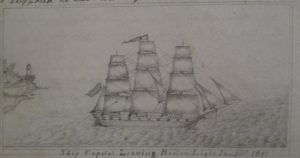
Background: Each year the Bancroft Library acquires a sizeable amount of new manuscript material. The sheer quantity of this material necessitates that the archivists who handle, process, and catalog these materials, exercise considerable judgment in balancing thorough and accurate descriptions that facilitate access with the need to make the materials available as quickly as possible. Archivists are trained to determine just the right level of description to allow for sufficient discovery. In the case of very large collections, an archivist rarely describes materials at the item-level.
But sometimes a single item merits closer examination and considerable research to render it truly accessible to the library’s researchers. One such item recently caught my attention–
The “Ship Capitol’s Log Book” is the account of a passenger aboard one of the first ships to head to California during the gold rush, arriving in San Francisco in July 1849.
At first glance, it looked like a typical gold rush era journal, with daily entries describing conditions and life aboard the ship as it made its way from Boston to San Francisco around Cape Horn. But this one stood out because it included several finely rendered pencil drawings throughout including ships, shorelines, and even an albatross at rest.
Unlike similar journals that have crossed my desk, this one came with a contemporary inscription inside the front cover identifying the ship and giving the date (and, incidentally, providing a neat title for the catalog record). The accompanying description provided by the vendor was also intriguing, noting that there was an additional inscription in a different hand: “Above this [title] is the inscription of Paul Maraspin, another passenger on the ship and the ancestor of the log’s most recent owner…. It is not clear who authored the journal.” However, upon closer examination, I determined that this might not be the case. It was clearly two initials followed by “Maraspin” but it didn’t look like either a “P” or “Paul.” I could not clearly make out the first initial, but the second one looked like an “L,” and below that a street address of “17 Court Street, Boston” and the date “Feb. 1917.”
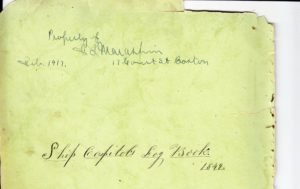
The vendor also noted that the lettering of the captions of the drawings was in a third hand, suggesting that someone other than the author of the journal might be the source of those. Also noted was the composer of several songs recorded in the journal, B.F. Whittemore.
The clues from the vendor and my own initial assessment of the journal suggested that a bit more research might make the journal infinitely more discoverable and useful. I became intrigued by the name of the owner of the journal, and the information suggested by the vendor just didn’t seem to fit with the facts the artifact was presenting to me.
Archivists have at their disposal the same research tools many other people do…the internet and access to genealogical sites that hold various records. There is a tremendous amount of information out there that makes this kind of research much more efficient than it used to be. Of course, too much information can also be problematic and it is the skillful researcher who can quickly sort through large amounts information and surmise whether more research will yield tangible results or, lacking that, have to call the effort “good enough.”
In this particular case, I discovered information about the owner’s signature that led to the solution of numerous puzzles presented by the journal itself, including how he came into possession of it, its likely author, the identity of the illustrator, the history of the lyricist of several songs, the author of the final song in the journal, and the history of the ship and its captain, Thorndike Procter.
Because Maraspin struck me as an unusual name, my first step was a Google search on the name. This resulted in the discovery of a Maraspin Creek in Barnstable, Massachusetts. Assuming the creek was named after a prominent family in the area, the information gave me hope that I could find out more about them and explore those connections.
I switched over to Ancestry.com to do a direct search on Paul Maraspin from Barnstable, Massachusetts around the time period of 1849. Numerous records surfaced that indicated a Paul Maraspin from Barnstable had been married and had several daughters, but none of whose initials matched the inscription in the journal. But then I found an application to the Sons of the American Revolution from 1937 for Paul Maraspin that listed his wife, Mary Eliza Davis, and one child, a son, Francis Lothrop Maraspin. Paul Maraspin had this son rather late in life, at the age of 52, and some 16 years after he had sailed to California. Looking back at the inscription, I could see now that the autograph was, in fact, “F.L. Maraspin.”
I then turned to confirming that this was, indeed, the Francis Lothrop Maraspin in the application form. Back to Google, I found an article from the Cape Cod Times lauding a Francis Maraspin’s 100th birthday in 1966. Back to Ancestry.com I found another Sons of the American Revolution application from 1935, this time for a Francis Lothrop Maraspin. I could see print coming through from the backside of the page and paged forward to see it. Right at the top was the statement identifying Paul Maraspin as his father. But the real clincher was at the bottom.The application was signed by Francis Lothrop Maraspin himself with his typed address, 17 Court Street, Boston.
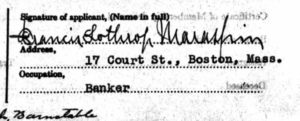
And from the journal again:

As you can see, the signature and address matched the inscription on the journal cover perfectly and we now knew we had our owner and could assume, with reasonable certainty, that the likely author of the journal was Francis Lothrop’s father, Paul Maraspin.
I shared these initial findings with my supervisor, Randal Brandt, who directed me to a publication that would be key to figuring out the rest of the puzzles. The Argonauts of California, published by C.W. Haskins in 1890, is an invaluable source of information about the gold seekers who came to California. The passenger lists it contains were crucial in figuring out the names of people associated with the journal. We now knew who had written the journal but who had done the drawings? And what about the composer of those numerous songs recorded in the journal? A closer examination of the drawings proved fruitful. Of the nine drawings, two of them had the initials “CCH” in the lower right hand corner.
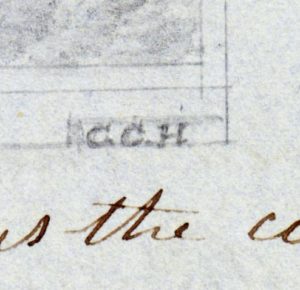
A quick perusal of the Capitol’s passenger list turned up only one possible match, a C.C. Hosmer. Now we knew the name of the illustrator. Back to Ancestry.com again, I went hunting for more information about him and found out his full name, Chester Cooley Hosmer (1823-1879). Because Chester Cooley Hosmer is also an unusual name, on a whim I Googled it along with the word “Capitol.” The very first result was a library catalog listing in the Special Collections of the Jones Library in Amherst, Massachusetts for Chester Cooley Hosmer’s journal documenting the same trip aboard the Capitol. Describing it as a journal “illustrated throughout with his drawings,” the catalog listing included scans of two pages with drawings. Here is one of them.
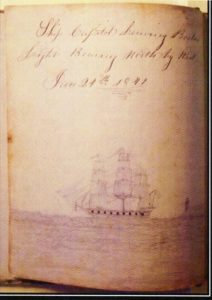
One can readily see the style of these drawings match those in the Maraspin journal. Not only did we now know our illustrator but also the location of his journal from the very same voyage.
Turning to the name listed as the songwriter, B.F. Whittemore (sometimes spelled incorrectly as “Whitmore” in passenger lists), a search turned up another interesting character. The Wikipedia entry for Benjamin Franklin Whittemore states that he went on to become a minister in the Union Army and then elected to the state legislature of South Carolina and eventually the House of Representatives.
Others identified in this process included the composer of the final song lyrics in the journal titled, “A Song Dedicated to the Officers of the Ship Capitol,” and signed “W.T. old friend.” Again, the passenger lists were the key as only one person had those initials, W.T. Hubbard.
More research on the ship and lists revealed the full name of the captain, Thorndike Procter of Salem, Massachusetts.
As might be true with any group of persons traveling so far from home for so long, there is inevitable tragedy as well as triumph. Captain Thorndike Procter committed suicide in San Francisco Bay on October 17, 1849. It was reported in the papers that the captain “had been lately subject to occasional fits of derangement, during the last of which he jumped overboard, and was drowned….” Nine weeks later, Paul Maraspin’s young “old friend,” William.T. Hubbard, just 23 years of age, also died by drowning in San Francisco Bay on Christmas Eve.
The work of improving access and discoverability to our collections is at the heart of what we do as library professionals. Unknown people become known, their stories and lives become real to us, and as you read this journal now you can see the intertwining of their lives. One hundred and sixty-eight years later, two journals from the same trip are virtually reunited because of the work of archivists and catalogers separated by time and a continent. In this way, library professionals contribute to a very large cultural jigsaw puzzle that, slowly but surely, becomes ever more complete.
To see the completed catalog record for this item please use this link:
http://oskicat.berkeley.edu/record=b23750637~S1
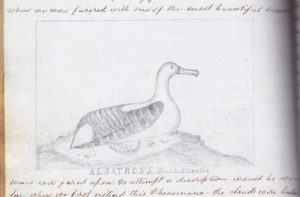
Social Problems During California’s Gold Rush Presaged Those We Face Today
by Louisa R. Brandt, an undergraduate student at UC Davis who spent her Summer 2015 break processing manuscripts at The Bancroft Library (originally posted to the “What’s New” blog on 2016/04/20)
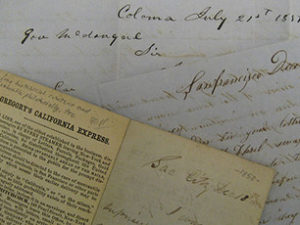
Gold Rush-era letters, and others like them, are open for research at The Bancroft Library. Visit the library to conduct your own inquiries into the experiences of Californians living through past booms and busts.
As the Eastern United States met the West in the months and years following the 1848 gold discovery at Sutter’s Mill, California’s shores and gold-filled hills became riddled with problems the eager prospectors might have thought they had left behind: racial tension, concern over rainfall, economic disparities between neighbors, overcrowding and high rent. These sound familiar, don’t they?
At The Bancroft Library, recent acquisitions of letters sent from California during this widely-studied era illuminate through the voices of young men, both optimistic and pessimistic, how they saw this “land of opportunity” and tried to explain it to their relatives and friends back home. Although many of the letter writers in this collection are not famous, and some even unidentified, the aggregate of their experiences and descriptions paint an honest likeness of this not-so-foreign past.
The influx of prospective miners into California after January 1848 brought the racist stereotypes regarding the native population already common in the East to the forefront of western social interaction. Common claims of the day deriding the character of the Indians are seen in the December 25, 1852 letter by Abram Lanphear to his brother in New York as he calls the native population a “poor indolent lazy set of mortals” (BANC MSS 2015/12). Similar ideas drove the state military’s pursuit of revenge for the death of one sergeant during an altercation that had already left eight native people dead, as explained by Brigadier General Albert Maver Winn’s July 21, 1851 letter (BANC MSS 2015/16). Some men were not so blindly willing to believe the prejudice against Indians, and asserted that this hatred was sometimes used to cover for violence between whites. A Virginian miner in Butte County tells a friend of the “band of robbers who committed such wholesale & fiendish murders in our neighborhood” leaving victims with their “throats cut & arrows stuck all over them.” Despite the attempt to make the murders fit the Anglo perception of native warfare tactics, the author does believe that the Indians are blamed “probably falsly [sic]” (BANC MSS 2014/19). This method of exploiting the new immigrants’ fear and ingrained ideas of native people attacking was also used in San Francisco, as carpenter Christopher Toole notes that “the great trouble is with the indians but….the fault is not with indians it is with the whites” (BANC MSS 2015/19). That some people saw through efforts to make them believe in the evil of the native people mirrors today’s concerns over racial profiling.
Due to the need for water to wash gold from the gravel pulled from mines, and the fact that too much water made it impossible to reach the ore-rich hills, the amount of rain and river water was an important subject for men in the fields and in the cities. Miners writing from their claims often wished for a “wet winter” in order to have the rivers filled throughout the spring and summer months (BANC MSS 2014/12). When the rains came at an inopportune time, however, as was the case during the late winter of 1850, it created chaos as a dry February caused “such rush for the mines you never see in your life,” and the succeeding wet March sent the prospectors flooding back into cities (BANC MSS 2015/19). This dependence upon the rain is familiar to today’s Californians, who daily hear about the prolonged drought, and the possible flooding that could occur if the projected El Nino winter proves to be as strong as predicted. Even though many people do not rely solely on water for employment, the concern over water is unabated, and remains as common a topic of conversation today as it was during the Gold Rush.
Like most new careers, digging for gold held its fair share of monetary risk and depended on luck. A man identified only as “Charles” observed in 1850 that “99 out of 100” men get not a cent from mining (BANC MSS 2014/53). While some men struck it rich upon arrival, many were not so fortunate and spent months in squalid conditions. The different financial outcomes between men who dug for gold in the same areas proves just how random success was, and can be reflected in today’s business environment in which one new technology soars while a similar one fails. Frank William Bye, a miner who spent at least a decade in California’s gold fields, noted in 1852 that he “cleared over one hundred dollars per month.” This success did not allow him to forget that he was one of the few, as he follows by conceding that “hundreds of men equally as competent as myself [who] have been here all summer spend the last dollar” (BANC MSS 2014/58). An unidentified miner digging at the Yuba River in the Sacramento Valley perfectly describes how big the difference a short distance can be in his assessment of a claim located less than a mile from his where “there was a company of 20 men making 20 to $30 a day while all around there was many not making their board.” (BANC MSS 2015/3). What are now entrenched issues of economic disparity were already at play in the 1850s.
Rent and the cost of food in California are prime examples of too much demand for not enough land and supplies. Even though there were vastly fewer people in gold rush San Francisco than there are today, numerous letters marvel over the enormous sums asked for rent, which were far larger than anywhere else in the country. Architect Gordon Parker Cummings, whose contributions to California include San Francisco’s “Montgomery Block,” and Sacramento’s capitol building, complains to a friend in Pennsylvania that his two “3rd story rooms” in San Francisco rent for $900 a month, a cost that “would sound extravagant in Phill [but] it is a cheap one here” (BANC MSS 2014/35). The cost of basic foodstuffs also was drastically more expensive in California thanks especially to the difficulty of moving provisions from the port of San Francisco to the mines. In an 1853 letter to a friend, Charles Stone, a miner in Columbia, California (now a state park), notes at the beginning of the letter that flour costs $0.38 per pound, and by the end of the letter, written after a rainstorm, it was raised to $0.75 per pound (BANC MSS 2014/36).
Despite all of the unexpected hardships, California still held its charm for some newcomers who boasted of its “handsome buildings” and health benefits that were “worth all the Gold in California” (BANC MSS 2014/13; BANC MSS 2014/3). Even today, California is a beautiful place to live and generally has salubrious weather. So maybe there is more than one reason that millions continue to call it home.
– Louisa Brandt